这篇文章来源于DevicePlus.com英语网站的翻译稿。
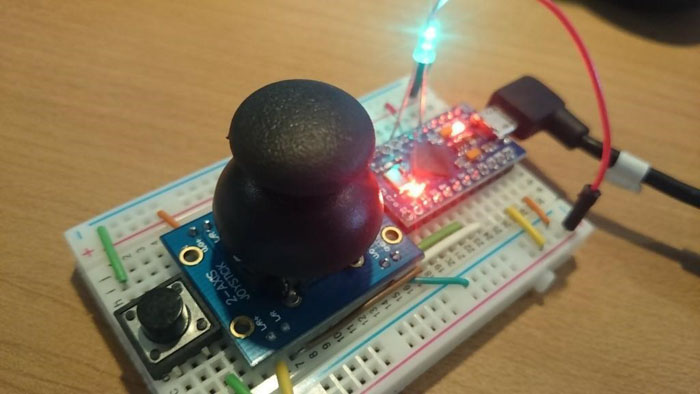
本文最初发布在deviceplus.jp网站上,而后被翻译成英语。
目录
前言
电子设计步骤
关于Arduino Pro Micro
使之被识别为HID
使用操纵杆创建鼠标设备
结论
相关文章
前言
本文中,我将介绍一种不一样的Arduino使用方式。乍一看,照片中的Arduino看起来像我们之前系列中使用过的Arduino Pro Mini,但其实这是另一种Arduino。它被称为“Arduino Pro Micro”。虽然“Mini”变成了“Micro”,尺寸却并没有发生任何变化,因此,两者有点难以区分。这种Arduino在连接到电脑时会被识别为鼠标或键盘等HID设备。
电子设计步骤
预计完成时间:60分钟
所需元器件
Arduino主机(Arduino Pro Micro)
面包板
双轴操纵杆模块#27800
轻触开关
220Ω 电阻
1. 关于Arduino Pro Micro
Arduino Pro Micro是一种Arduino,配备有名为“ATmega32U4”的芯片(UNO等配有ATmega328P等)。该芯片最大的特点是当通过USB连接时会伪装成键盘和鼠标等人机接口设备(HID)。配备ATmega32U4的Arduino除了“Pro Micro”之外,还被称为“Arduino Leonardo”,是非常有名的开发板。
在编写程序时,您可以选择名为“Arduino Leonardo.”的开发板。
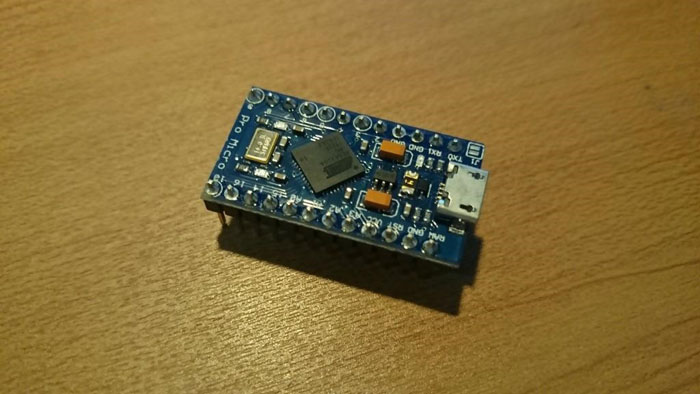
乍一看,Arduino Pro Mini与Arduino Pro Micro的外观非常相似。
但是,Pro Micro具有可以连接到智能手机等设备的USB连接器,而Pro Mini只有一个串行连接器。
2. 使之被识别为HID
现在,我们让外观相似的Arduino Pro Micro读取示例程序并尝试让电脑将其识别为HID。
尝试运行Arduino IDE的“File”-“Sketch Example”-“09.USB”-“Keyboard”-“KeyboardMessage”程序。
在这个程序中,我们创建一个在引脚4上设有开关的简单电路,当引脚4被按下时,应通过键盘输入显示按下的次数。
(这次,我将引脚4改换为引脚7)
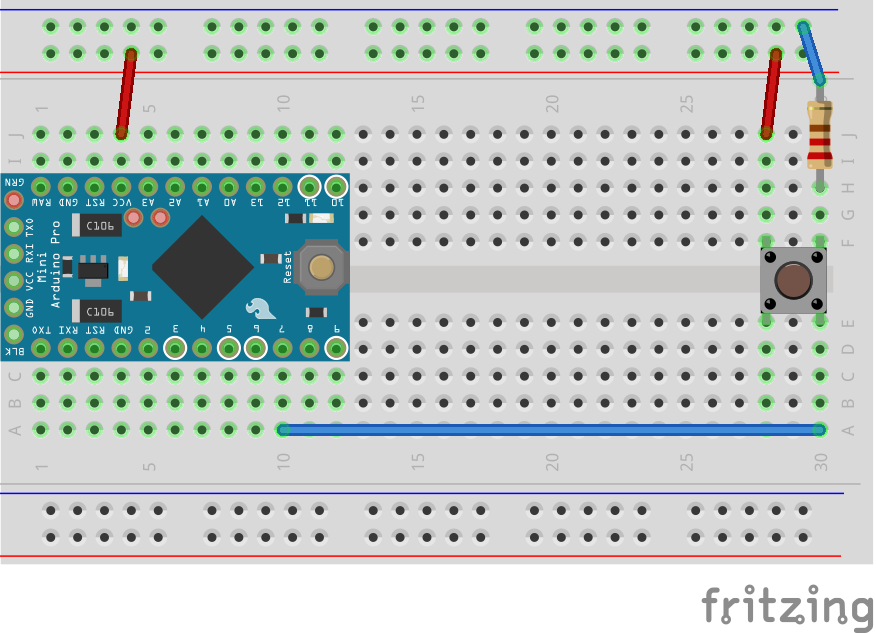
#include "Keyboard.h" const int buttonPin = 7; // input pin for pushbutton int previousButtonState = HIGH; // for checking the state of a pushButton int counter = 0; // button push counter void setup() { // make the pushButton pin an input: pinMode(buttonPin, INPUT); // initialize control over the keyboard: Keyboard.begin(); } void loop() { // read the pushbutton: int buttonState = digitalRead(buttonPin); // if the button state has changed, if ((buttonState != previousButtonState) // and it's currently pressed: && (buttonState == HIGH)) { // increment the button counter counter++; // type out a message Keyboard.print("You pressed the button "); Keyboard.print(counter); Keyboard.println(" times."); } // save the current button state for comparison next time: previousButtonState = buttonState; }
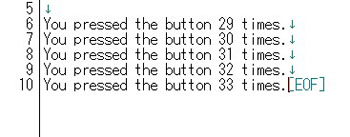
编写程序并打开记事本后,无需触碰键盘,每按一次按钮,就会按照上面的描述进行计数。
如果可以如此轻松地制作USB设备,那么就可以实现更多梦想!
3. 使用操纵杆创建鼠标设备
我们已经知道Arduino Pro Micro可以用作HID,下面我想通过将它与其他一些元器件组合来创建鼠标设备。这一次,我将使用曾经在无线电控制设备制作中使用过的操纵杆,并尝试创建一个可以用操纵杆和轻触开关来代替鼠标的设备。
首先,准备一个可用于设置操纵杆方向的程序。

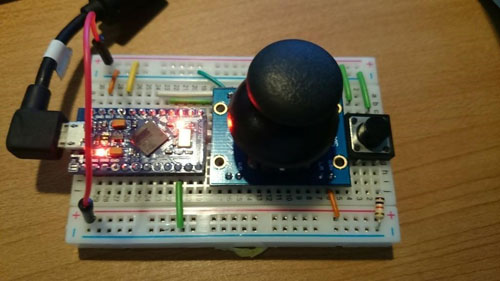
将电路添加到之前的轻触开关电路中。将操纵杆和后面要使用的LED连接到引脚2。
Code Example
const int _UDPIN = A0; // UD Input
const int _LRPIN = A1; // LR Input
const int _SWPIN = 7; // Digital Pin
int _UD = 0; // Value for Up/Down
int _LR = 0; // Value for Left/Right
void setup() {
Serial.begin(9600);
pinMode(_SWPIN,INPUT) ;
}
void loop() {
_UD = analogRead(_UDPIN);
_LR = analogRead(_LRPIN);
Serial.print("UP-DOWN:");
Serial.print(_UD, DEC);
Serial.print(" - Left-Rright:");
Serial.println(_LR, DEC);
if (digitalRead(_SWPIN) == HIGH) {
Serial.println("switch on");
}
delay(100);
}
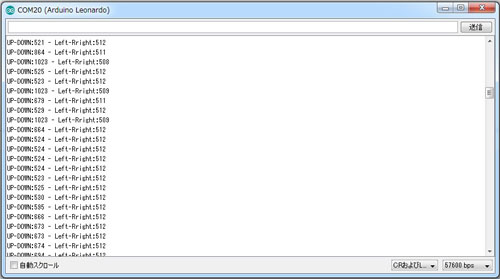
经过确认,可以知道它读取了程序,转动操纵杆时数字会发生变化。
接下来,让我们将操纵杆数字值转换为鼠标坐标。实际上,这个程序也是已经备好的示例程序,所以让我们来用用看。请选择“File”-“Sketch Example”-“09.USB”-“Mouse”-“JoystickMouseControl”。
执行此程序时,会将上下(模拟引脚A2)和左右(模拟引脚A1)的值反映在鼠标坐标上。此外,由于引脚2通过接入5V电源来实现开关功能的,因此可以通过将引脚2与VCC相连或将开关夹在中间的方式来打开/关闭设备。
Code Example
#include "Mouse.h" // set pin numbers for switch, joystick axes, and LED: const int switchPin = 5; // switch to turn on and off mouse control const int mouseButton = 7; // input pin for the mouse pushButton const int xAxis = A1; // joystick X axis const int yAxis = A2; // joystick Y axis const int ledPin = 2; // Mouse control LED // parameters for reading the joystick: int range = 12; // output range of X or Y movement int responseDelay = 5; // response delay of the mouse, in ms int threshold = range / 4; // resting threshold int center = range / 2; // resting position value boolean mouseIsActive = false; // whether or not to control the mouse int lastSwitchState = LOW; // previous switch state void setup() { pinMode(switchPin, INPUT); // the switch pin pinMode(ledPin, OUTPUT); // the LED pin // take control of the mouse: Mouse.begin(); } void loop() { // read the switch: int switchState = digitalRead(switchPin); // if it's changed and it's high, toggle the mouse state: if (switchState != lastSwitchState) { if (switchState == HIGH) { mouseIsActive = !mouseIsActive; // turn on LED to indicate mouse state: digitalWrite(ledPin, mouseIsActive); } } // save switch state for next comparison: lastSwitchState = switchState; // read and scale the two axes: int xReading = readAxis(A0); int yReading = readAxis(A1); // if the mouse control state is active, move the mouse: if (mouseIsActive) { Mouse.move(xReading, yReading, 0); } // read the mouse button and click or not click: // if the mouse button is pressed: if (digitalRead(mouseButton) == HIGH) { // if the mouse is not pressed, press it: if (!Mouse.isPressed(MOUSE_LEFT)) { Mouse.press(MOUSE_LEFT); } } // else the mouse button is not pressed: else { // if the mouse is pressed, release it: if (Mouse.isPressed(MOUSE_LEFT)) { Mouse.release(MOUSE_LEFT); } } delay(responseDelay); } /* reads an axis (0 or 1 for x or y) and scales the analog input range to a range from 0 to */ int readAxis(int thisAxis) { // read the analog input: int reading = analogRead(thisAxis); // map the reading from the analog input range to the output range: reading = map(reading, 0, 1023, 0, range); // if the output reading is outside from the // rest position threshold, use it: int distance = reading - center; if (abs(distance) < threshold) { distance = 0; } // return the distance for this axis: return distance; }
完成编程后,我们来尝试让它动起来。
哦,它真的动起来了!
结论
这次,我们学习了使用Arduino Pro Micro创建基于Arduino的USB设备时的基本流程。在下一篇文章中,我们将进一步深化应用Arduino Pro Micro,尝试创建更具“Device Plus”风格的USB设备,让项目更具挑战性!
审核编辑:汤梓红
-
usb
+关注
关注
60文章
8020浏览量
267086 -
HID
+关注
关注
2文章
131浏览量
46836 -
Arduino
+关注
关注
188文章
6478浏览量
188457
发布评论请先 登录
相关推荐
怎样制作一个基于Arduino Pro Micro与ADXL345的陀螺仪体感鼠标呢
制作基于Arduino的多功能电能表
使用Arduino pro micro的USB垫
使用arduino pro micro制作一个游戏控制器
分享一个不错的使用Arduino Leonardo PC音量控制的项目
怎样用Arduinopromicro将电脑触控板转换为USB设备
使用Arduino Leonardo和红外传感器制作手势控制设备

用Raspberry Pi和Arduino Micro制作的虚拟窥视孔





 可以用Arduino来制作USB设备吗?尝试通过Arduino Pro Micro(Leonardo)使用HID功能
可以用Arduino来制作USB设备吗?尝试通过Arduino Pro Micro(Leonardo)使用HID功能
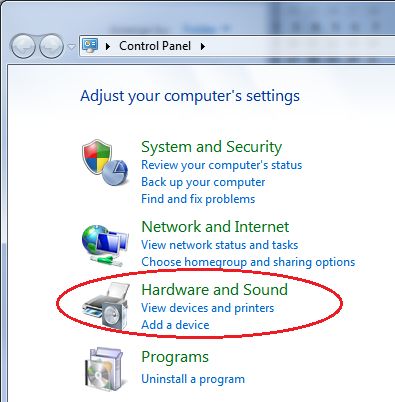











评论